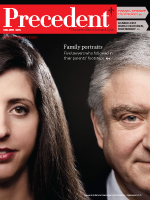
Who are the Seven Sisters?
In ancient Greece, sailors relied on a group of stars they called the Seven Sisters to guide their ships. The term is now used to describe the top seven of just about anything — from liberal arts colleges in the Northeastern United States to Stalinist skyscrapers in Moscow. The phrase was popularized by Lexpert Magazine founder John Black in a 2003 article where he anointed Blakes, Davies, Goodmans, McCarthys, Osler, Stikeman, and Torys as the “heavy hitters” in corporate law.
Five years later, these firms maintain their status despite a Financial Post report that the seven siblings were lead counsel in only 25 percent of 2007 deals. Black claims that club membership can change, but the rules remain a secret. A 2006 Globe and Mail article argued there were really only four top players, leading Lawbuzz’s catty forum posters to proclaim that the sisters have been reduced to a “Fab Four.”
Should I apply to New York firms?
Take Bay Street, add a gold card and bottle service, and you’ve got your New York summer job (hopefully at a white shoe firm, but that’s another Q&A). Big Apple summer students are reported to be out on the firm’s dime three or four nights a week, rolling into the office at 10 a.m. and letting long, boozy lunches cut into their workday. Rumour has it that one intrepid group of students went so far as to take the corporate credit card to Paris for a night after being told to “do whatever they wanted” with it.
Advantages? After being a total baller all summer, you can skip articling, and jump right into a first-year associate gig with twice as much cash as your Toronto counterparts. Disadvantages? The 80-hour workweeks might not leave you much time to see New York (or anything else). Many also face potential licensing obstacles when attempting to return home (and let’s face it: no one wants to be the 35-year-old articling student).
Are there foods I should avoid at cocktail parties?
The recruitment process is already a minefield of social missteps, and food is one of the biggest. Getting the canapé from the silver serving tray into your waiting piehole is fraught with obstacles: forced to juggle drinks, plates, napkins, shrimp tails, and handshakes, more than one law student has cracked under the strain. A few pointers on how to nosh like a pro:
- Eat before you go: it will save you from blathering on inappropriately after drinking on an empty and nervous stomach.
- Think before you eat: choose foods according to your face-stuffing dexterity, and don’t be a hero. Choose bite-sized, low-spatter foods. Slobs should avoid dips (or carry a detergent pen). Hand-talkers should dispose of skewers promptly. Avoid “shrimp hand.”
- Keep your eye on the prize: It’s an audition, not a meal. Firms provide food and drink as a social lubricant, so use it to your advantage and find ways to meet people. Uncomfortable food situations can sometimes be turned into icebreakers, such as, “Hey, the crab cake I just stuffed in my face reminds me that I need a drink, do you want one?”
Business Casual: neither business, nor casual. Discuss.
Most Bay Street firms have adopted a “business casual” dress code, but don’t be fooled: the operative word is still “business.” Different firms have varying levels of formality in their dress codes, so pay attention, and avoid being the person who instigates the office-wide email “reminder” of the dress code policy. In general, guys wear jackets (but not always ties) and dress pants; girls can get by without a suit, but must look professional and put-together.
So on Friday I can wear whatever I want?
The dot-com boom in the late ’90s pushed casual Fridays to new levels of slobbery, some companies even allowing shorts and sandals, jeans and golf shirts. Most businesses have since returned to a more buttoned-up version of casual Friday, allowing khakis and polo or golf shirts, and in some cases, jeans, capris, and running shoes. That said, casual Fridays do not give you carte blanche to show off your favourite clubbing outfit or ignore basic rules of hygiene and style.

This story is from the 2008 edition of PrecedentJD Magazine
